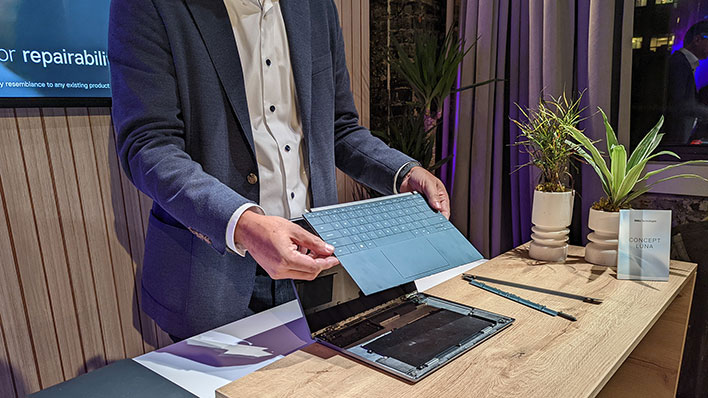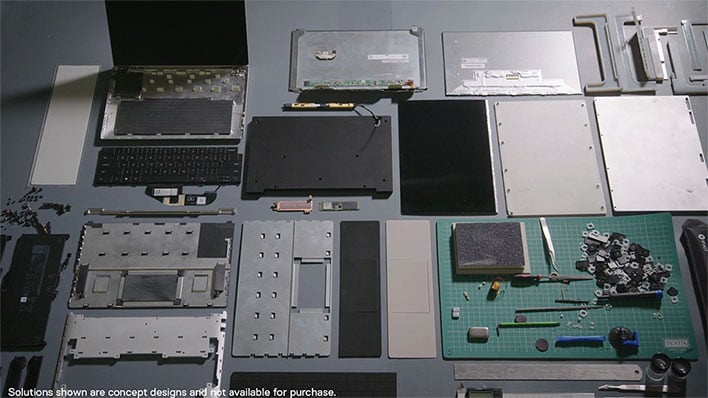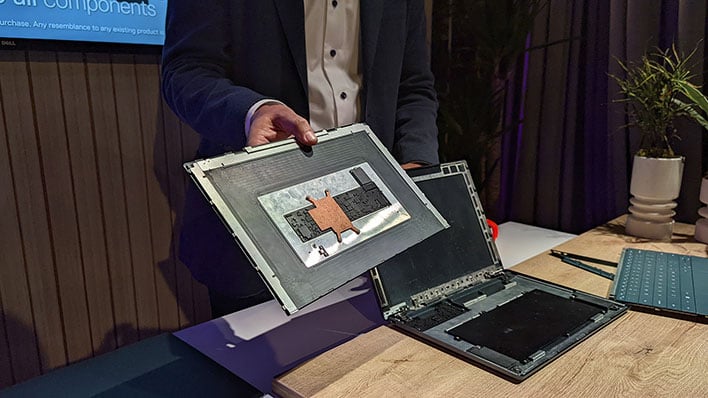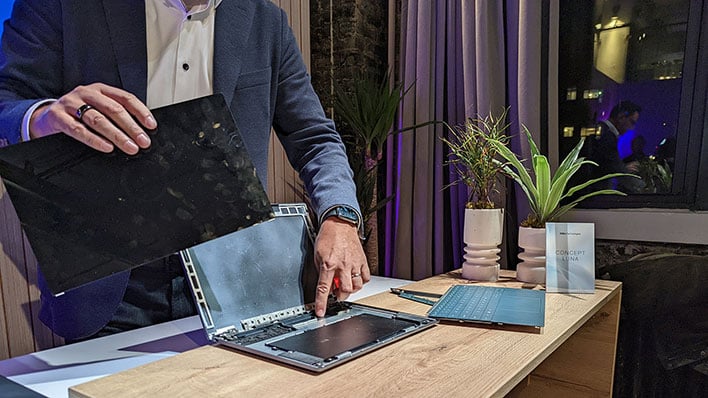Dell's Concept Luna Modular Laptop: Enterprise, Right To Repair And Environmental Game-Changer
Companies in recent years have put added emphasis on reducing their carbon footprints, taking a more responsible approach to environmental challenges that are exacerbated by heightened consumerism. From manufacturing to disposing of electronics, energy consumption and e-waste are growing issues. They're also somewhat compounded by a push for thinner and lighter products—premium designs can and often do come at the expense of easy repairs and scenarios where a product can be reused beyond its initial lifecycle. It doesn't have to be that way, though. In an effort to push the limits of sustainable PC design, Dell today introduced an interesting prototype laptop called Concept Luna.
Concept Luna was born out of growing concerns about the climate crisis, e-waste, and resource constraints. It's also an initial answer to a question Dell posed to itself: "What if we could push reuse to the limit and dramatically reduce the carbon footprint of our products?" The question comes at a time when Dell says its ambitious goals to accelerate the circular economy and achieve net zero greenhouse gas emissions have never been more mission critical. Meaning the time to act is now, not tomorrow.
Dell collaborated with Intel on Concept Luna, a proof-of-concept laptop that "explores revolutionary design ideas" aimed at making components immediately accessible, replaceable, and reusable (in the photo above, you can see the keyboard detached, which is designed to slide and clip out—there are no ribbon cables, etc.)
It's a modular laptop, but also a test vehicle of sorts, to see what is possible (as opposed to designing a product to be manufactured and sold right away). In that sense, the modular laptop can serve as a blueprint for future products. To that end, if every part of Concept Luna were realized, Dell says the overall product carbon footprint would be cut in half.
That's an attractive proposition, especially for the enterprise/IT sector. The ideal initial use case for something like this would be an enterprise fleet PC application where IT would send systems to Dell to reclaim and update to the latest platform technology, and then re-deploy. It's a better alternative to throwing out or recycling dated systems and buying brand new ones.
Reducing the carbon footprint is not the only aspect of Concept Luna, though it's a major part of it. Dell said it looked at ways to increase energy efficiency and deliver better power and cooling. It also experimented with materials that have a smaller carbon footprint.
One of main areas for this effort is the motherboard, as it consumes more energy than any other component to manufacture. Dell claims that by shrinking the total area by 75 percent (making it smaller than 5,580 mm2) and reducing the component count by 20 percent, it can scale back the carbon footprint of the motherboard by 50 percent.
Dell also "completely reconsidered the layout of all internal components." By making the motherboard so much smaller, it was able to relocate it underneath the top cover rather than at the base where it sits in every other laptop. This has the benefit of exposing a larger surface air to outside air. It also separates the main components of the laptop from the main battery back, which in turn can lead to improved passive heat distribution. According to Dell, this could eliminate the need for a cooling fan.
That battery pack, by the way, is an advanced deep-cycle cell battery that is designed to hold a charge through years of use, well beyond the laptop's first lifecycle. This makes refurbishing and reusing the laptop a more feasible proposition.
On the manufacturing side, Concept Luna employs an aluminum chassis, which in and of itself is not unusual. In this case, however, the stamped aluminum construction is processed using hydro power, which requires less energy and reduces scrap metal.
It also leverages a bio-based printed circuit board (PCB constructed with flax fiber in place of traditional plastic laminates in the base, with a water-soluble polymer serving as the adhesive. The latter is especially helpful when it comes to repairs—Dell says it can dissolve, making it more easy to pry apart metals and components from the boards. In the picture above, you can see the display panel detached from the laptop assembly.
"Our position is simple. We need to move from use, then recycle—to use, reuse multiple times, and then recycle when the material is no longer usable in its original form. This iteration of Concept Luna does just that. It shows a vision for what could be," Dell says.
This is also only the first step, that being to prove what is possible. The next step is to evaluate which of these design characteristics have a realistic shot at scaling into actual products sold to enterprise customers and perhaps home consumers at some point. And as time goes on, Dell intends to continue iterating on this concept.






